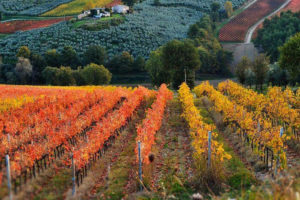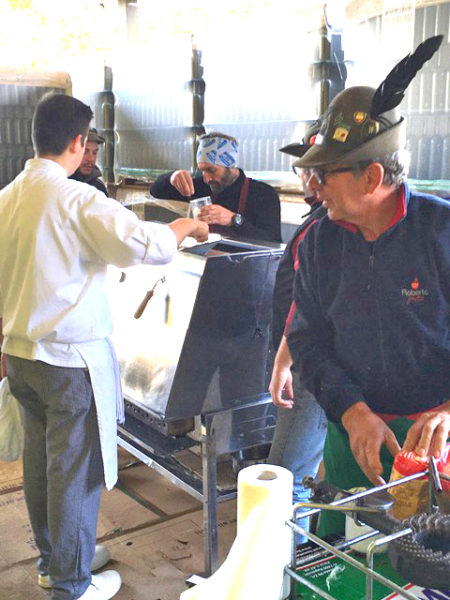ANTEPRIMAS AND ALPINI
A SHORT PREFACE
I took the train from Verona to Umbria to attend Anteprima [preview of] Sagrantino. People in the train wore masks over their noses and mouths and the air was infused with the fierce lemony-sweet scent of handwash. Hushed voices whispered: “Coronavirus.” I switched on the TV in my hotel room and listened to non-stop news of doom and announcements about quarantining cities in the Veneto. By the time I had dressed and huffed and puffed my way up Montefalco’s steep main street, my mind was filled with worst-case scenarios, including the possibility that authorities would quarantine Verona and I would not be allowed back to my home. Fortunately, I ran into Daniele Cernilli in the piazza. He gave me some much-needed advice: Don’t succumb to this mass hysteria. Indeed, within 48 hours the news channels were echoing his words.
A note about the virus: The reason Italy has a large number of reported cases of the virus is because the authorities are testing for it. The government has acted immediately and responsibly. My concerns are for countries where no precautions have been taken.
ANTEPRIMA SAGRANTINO

Courtesy of Villa Mongalli
Sagrantino di Montefalco is one of Italy’s greatest red wines. Though the variety’s origins are uncertain, it is hypothesized that it was imported by Byzantine monks from Greece during the Middle Ages. At that time Montefalco was strictly a religious community, with wine playing an important role in its rites and ceremonies. Sagrantino’s name, in fact, is most likely derived from sagrestia or sacrestia (vestry), and it should be remembered that sacro (holy) and sagra (celebration) share the same root.
Sagrantino grapes have medium to thick skins, which results in wines that have deep (red/purple) color. The variety also accumulates high levels of tannins, resulting in wines with extraordinary longevity. Some producers I spoke with said that Sagrantino reaches its stride at around fifteen years from the vintage. From that point, the wines can easily continue giving pleasure for much longer. I tasted several wines from between 1996 and 1999, and each had maintained its fresh, pure elegance.
Producers to seek out (listed in alphabetical order): Adanti, Arnaldo Capri, Bellafonte, Bocale, Dionigi, Moretti Omero, Pardi, Tabarrini and Villa Mongalli. Are there other fine producers in the zone? Absolutely, this list is composed only of the wines that I tasted and particularly enjoyed. One point to mention, I often found the cru (single vineyard) wines to be particularly interesting expressions of the variety and well worth the extra cost per bottle.
ANTEPRIMA AMARONE
For my book on Amarone, published in 2000, I tasted every Amarone that was commercially available: there were forty-eight. That number soon doubled. As growth continued with the addition of new producers or simply crafty marketers, the wine entered its uncomfortable adolescence. It was neither fish nor fowl. Some producers made great hulking muscular wines which were often teetering on the delicate cusp of drinkability, while others designed wines to satisfy the need for quick easy sales at low prices. The core of small independent producers, I hasten to say, quietly soldiered on making wines with style and personality that dignified the name Amarone. However, the presence of these disparate styles created confusion in the minds of consumers in foreign markets as well as in Italy.
This year’s Anteprima Amarone tasting (held annually in Verona, Italy), presented the 2016 vintage. It was a revelation. It marked a profound change from previous vintages. Across the board the wines I tasted burst with lively acidity that buoyed the fresh, clean fruit and gave a new elegance to the wines.
I quizzed producers about this welcome and intriguing evolution in style, and determined it is the result of the merging of three elements.
First, climate change has created generally warmer, drier conditions that impact upon the development of the grapes in the vineyard and during appassimento. Appassimento refers to the period in which grapes destined for Amarone production are semi-dried. It is what sets Amarone apart from other fine wines and gives it its distinct character. A few years ago, it was common for heavy autumn mists to envelope Verona and Valpolicella for weeks on end. This no longer occurs. Fewer days of moist winter fog reduces the potential for the development of mold on drying grapes. This, in turn, helps to maintain the purity of the fruit. More than one producer told me apologetically: Climate change is bad for the planet but – at least for now – it has been good for Amarone.
Second, subtle changes in production methods that began some years ago are now more widely accepted. Longer, slower fermentation, for example, enhances the varietal characteristics and aromas in the resulting wines. While planting vineyards at higher altitudes creates conditions that favor the development of more concentrated color as well as an increase in acidity that leads to fresher and more complex wines.
Third, there has been a change in the mentality of a significant number of producers. A clear idea of style is emerging, one on which most can agree. The future of Amarone now lies in its elegance and freshness, underpinned by the distinct complexity that comes from the use of appassimento on local grape varieties. With this precise quality goal in place, the future looks bright for Amarone and for those who appreciate the intellectual and sensual pleasures of fine wine.
LUNCH WITH THE ALPINI

We arrived at Brescia train station to find a nice man waiting to whisk us to La Cooperativa Vitivinicola Cellatica Gussago (www.cvcgwine.it/) for the coop’s 70th-anniversary celebration.
The food for the event was prepared by the Alpini, who manned the rotisserie and stirred the polenta pot.
The Alpini are members of the specialized mountain warfare infantry corps of the Italian Army, established in 1872. The term also refers to members of the National Alpini Association, which is made up of former soldiers who volunteer their help for civil defense operations and for cleanup and rescue services following natural disasters. They are also known for their love of good food and wine and are happy to pitch in at local events, as was the case today.
150 guests sat down for lunch. The head table was packed with seventeen politicians, historians, and generally jolly people, all waiting to contribute their 2-cents worth prior to the meal. The moderator kicked things off by saying: “The Alpini told us that at 12:15 the speidini (roast meat) will be on the tables. So, we will keep to their time”.
The coop is located on the eastern edges of the Franciacorta zone, and produces four styles of Franciacorta sparkling wine, as well as five reds and a simple white.
My favorite wine of those I tasted was the
Curtefranca Rosso 2016 DOC Conchèt (a blend of Cabernet Franc, Cabernet Sauvignon, Merlot and Carmenere). It has a vibrant bruised plum infused ruby color. The nose is compressed, almost linear at first. It opens after 10 minutes in the glass to reveal soft brambly Merlot character. It was a good match for the smoky flavors of the meat and polenta. At a wine shop price of 5.50 Euros, it is a bargain.
So where can you find this wine? I spoke with the agronomist who assured me that they were looking to expand their client base and mentioned customers in Switzerland and Milan, but for now the company’s wines are mainly sold locally.
Importers might want to check out La Cooperativa Vitivinicola Cellatica Gussago: they have a young and well-prepared winemaking and sales team and are very eager to enter new markets.
